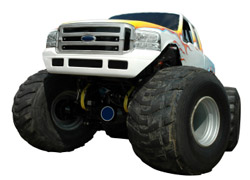June 2008 was a calamitous disaster for new-car sellers all the way, to tap a baseball term, around the horn.
Well maybe not at every base. Mid-size and crossover vehicles surprised auto executives and analysts alike, faring decently among a battlefield of gloom.
People Just Aren’t Buying
 Autodata Corp., which monitors and reports on vehicle sales, noted that the month was one of the worst car-selling months in many years, with sales dropping 18.3% compared with the same month a year earlier.
Autodata Corp., which monitors and reports on vehicle sales, noted that the month was one of the worst car-selling months in many years, with sales dropping 18.3% compared with the same month a year earlier.
Sales figures were shackled by a 28.4% decline in sales of pickup trucks and sport utility vehicles – based of course on their poor fuel economy in this high-gas-price era.
Nonetheless, many mid-size vehicles logged double-digit jumps in sales.Â
Industry watchers highlighted models such as the Chevrolet Malibu and Honda Accord sedans, up in sales by 73.4% and 54%, respectively.
Even the Pontiac G6 sedan – not exactly a household name – jumped more than 34% in sales in June 2008 compared with June 2007.
Note that all three mid-sized sedans get 24 to 25 miles per gallon.
What industry experts are saying, at least until the next monthly sales figures arrive, is people want to go smaller with cars, just not to the extreme. Not yet, anyway.

Americans Straddling the Middle, Of Course
The mid-size car is the most popular size and classification of car in America.
It makes sense considering where Americans stand today, right in the middle, where red and blue balance equally, and no presidential race has been a landslide in more than a decade.
Be too conservative and you can be a castoff. Likewise if you’re too far to the liberal left.
When push comes to shove, American motorists parallel the trend. They stick to the middle ground.
It is worth noting, however, that if Toyota and Honda could have built more Prius and Civic models faster, the scales could have tipped more in favor of the hybrid classification and chipped away at recent mid-size car sales.
It’s an indication that if potential owners could, they would have purchased more hybrids.
However, both models experienced a considerable drop in sales in June 2008. The Prius, getting an astonishing 46 miles per gallon, fell 25.5%, while the 42-miles-per-gallon Civic hybrid tumbled 6.1%.
Industry experts say there just weren’t enough models available to be sold.
So all those people who were selling their SUVs and trucks, who desired better fuel economy, couldn’t go into hybrid territory because there were no hybrids to be had. They turned to mid-size.
Gas-sipping mid-sizers and crossovers were around for $18,000 to $30,000, and buyers hurried them off the lots.
Grey Area in Mid-Size Classification
 Another factor is many buyers’ needs just could not be met by the ultra-small compact cars entering the market.
Another factor is many buyers’ needs just could not be met by the ultra-small compact cars entering the market.
The fuel-economy factor still applied, but buyers needed the extra seating or space that new mid-size cars offered.
Mid-size vehicles today can come as sedans, coupes or convertibles.
It’s interesting to note that historically the industry struggled to define a mid-size vehicle, and the classification fluctuated from its inception in the early 1960s into the late 1970s.
Then, as today, rising fuel costs forced the hand. The EPA got involved, and measurements were changed from simple wheelbase measurements to passenger and cargo space.
Automakers began downsizing. For example, Chevrolet shrunk its Malibu down to a 108-inch wheelbase – something unheard of in the muscle car-heavy 1960s.
Later, imports that were classified as compact in the mid-1980s were later deemed by the EPA as mid-size a decade later. The classification was growing.
Today, mid-sizers range in wheelbase size between 105 and 110 inches. Another measurement to qualify for the classification is having between 110 and 119 cubic feet of interior space.
Ultimately today it boils down to miles per gallon.Â
Here are a few mid-size cars that get the most mileage per gallon
Chevrolet Malibu – Chevy has redesigned and redefined its Malibu into a gas-sipping machine. Its models ranging from a four-cylinder to a six-cylinder to a hybrid get up to 32 miles per gallon, with the low being the six-cylinder, 3.6-liter-engine model’s 17 mpg in the city and 26 mpg on highways.
Chrysler Sebring – Its four-cylinder, 2.4-liter automatic four-speed model gets 21 to 30 miles per gallon.
Hyundai Elantra – Offers 24 to 33 miles per gallon.
Kia Spectra – Provides 24 to 23 mpg.
Nissan Versa, Altima and Sentra – Display a nice range of strong fuel economy ranging up to 33 mpg.
Saturn Aura Hybrid – Gets 24 to 21 mpg.
Toyota Camry – Presents 21 to 31 mpg, bumping up to 33 to 34 in its hybrid version.
Now its Easy to Pick, Right?
Now that you know the most fuel effecient cars on the road right now, if you must pick a mid-size vehicle, pick responsibly.
